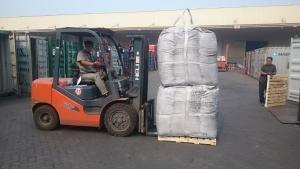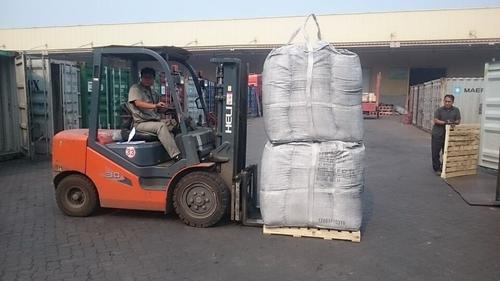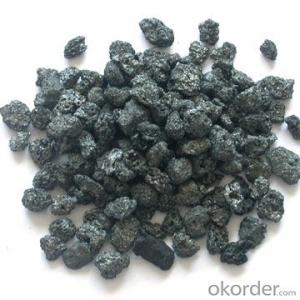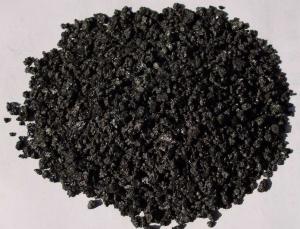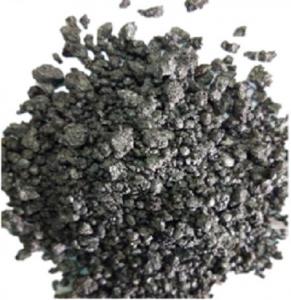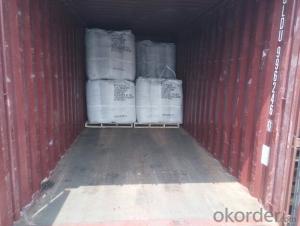Graphite Petroleum Coke with lower Sulphur0.03% max in Low VM
- Loading Port:
- Tianjin
- Payment Terms:
- TT OR LC
- Min Order Qty:
- 21 m.t.
- Supply Capability:
- 5000 m.t./month
OKorder Service Pledge
OKorder Financial Service
You Might Also Like
Introduction:
GPC has good characteristics with low ash, low resistivity, low sulphur, high carbon and high density. It is the best material for high quality carbon products. It is used as carbon additive in steel industry or fuel.
Features:
1.Our strong team provide you reliable service that make you feel purchasing is more easier
2. We ensure that we can supply capability with competitive price.
3. Work strictly to guarantee product quality,
4. Highest standard of integrity. Guarantee customer's benefit.
5. Supplying Pet Coke, Met coke, Foundry Coke, Carbon Raiser etc.
Specifications:
F.C.% | 95MIN | 94MIN | 93MIN | 92MIN | 90MIN | 85MIN | 84MIN |
ASH % | 4MAX | 5MAX | 6 MAX | 6.5MAX | 8.5MAX | 12MAX | 13MAX |
V.M.% | 1 MAX | 1MAX | 1.0MAX | 1.5MAX | 1.5MAX | 3 MAX | 3 MAX |
SULFUR % | 0.3MAX | 0.3MAX | 0.3MAX | 0.35MAX | 0.35MAX | 0.5MAX | 0.5MAX |
MOISTURE % | 0.5MAX | 0.5MAX | 0.5MAX | 0.5MAX | 0.5MAX | 1MAX | 1MAX |
Pictures

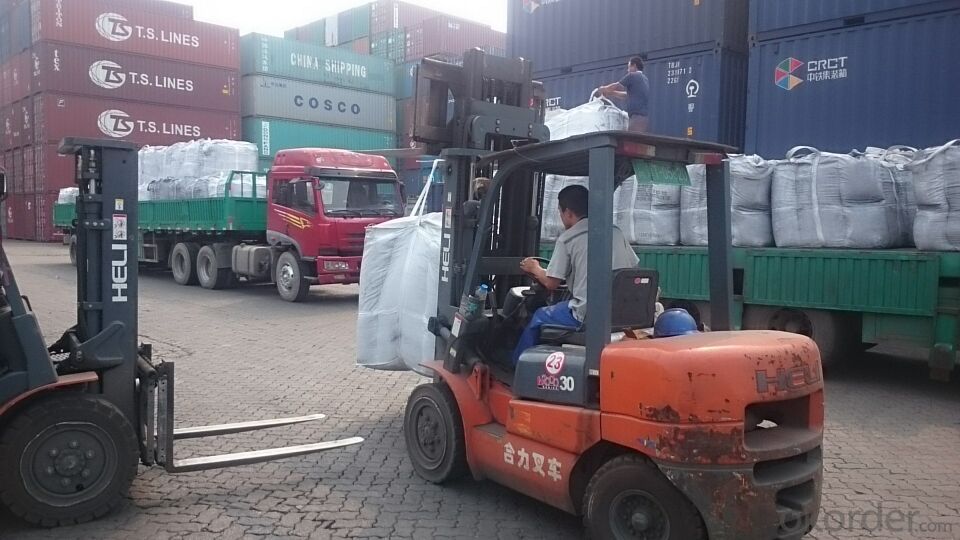
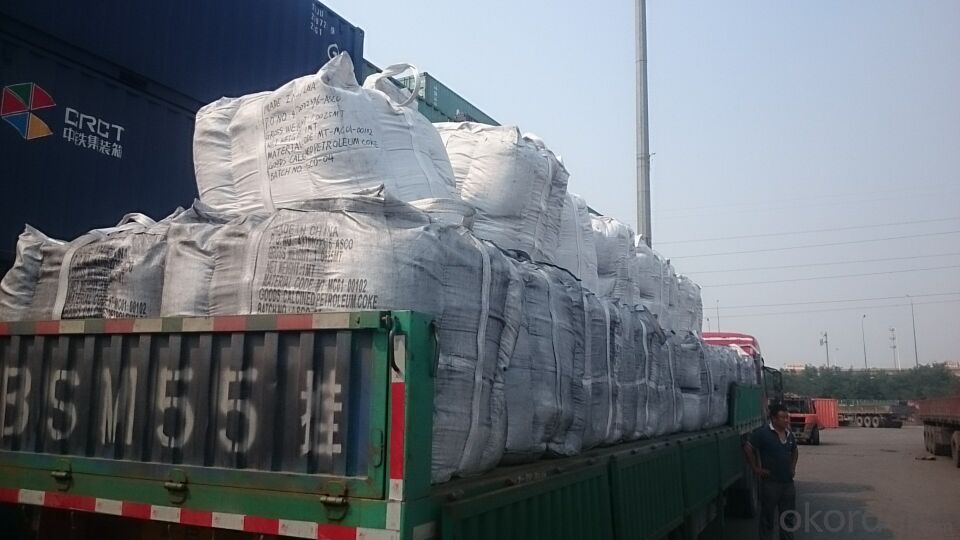
FAQ:
1. Your specification is not very suitable for us.
Please offer us specific indicators by TM or email. We will give you feedback as soon as possible.
2. When can I get the price?
We usually quote within 24 hours after getting your detailed requirements, like size, quantity etc. .
If it is an urgent order, you can call us directly.
3. Do you provide samples?
Yes, samples are available for you to check our quality.
Samples delivery time will be about 3-10 days.
4. What about the lead time for mass product?
The lead time is based on the quantity, about 7-15 days. For graphite product, apply Dual-use items license need about 15-20 working days.
5. What is your terms of delivery?
We accept FOB, CFR, CIF, EXW, etc. You can choose the most convenient way for you. Besides that,
we can also shipping by Air and Express.
6. Product packaging?
We are packed in bulk ship or in ton bag or placing in container or according to your requirements.
7. Notice
please note that the price on Alibaba is a rough price. The actual price will depends on raw materials, exchange rate wage and your order quantity .Hope to cooperation with you, thanks !
- Q: How does carbon impact the prevalence of tsunamis?
- The prevalence of tsunamis is not directly impacted by carbon dioxide. Tsunamis primarily occur due to undersea earthquakes, volcanic eruptions, or underwater landslides. These events release massive amounts of energy into the water, creating powerful waves that can travel across the ocean and cause devastating destruction upon reaching the coast. Although tsunamis are not directly caused by carbon dioxide emissions, there is a connection to climate change, which can indirectly influence the frequency and impact of these natural disasters. The increased levels of carbon dioxide and other greenhouse gases in the atmosphere contribute to global warming, resulting in the rise of sea levels. As the sea levels rise, coastal areas become more susceptible to the destructive force of tsunamis, as the waves can penetrate further inland. Additionally, climate change can also have an impact on the frequency and intensity of extreme weather events like hurricanes and tropical storms. These weather patterns can trigger underwater landslides or increase the likelihood of volcanic eruptions, both of which can lead to the occurrence of tsunamis. In conclusion, while carbon dioxide emissions do not directly cause tsunamis, they do play a role within the broader context of climate change. This indirect impact can result in rising sea levels and the potential for more frequent extreme weather events, ultimately affecting the prevalence and impact of tsunamis.
- Q: What are the impacts of carbon emissions on human health in developing countries?
- The impacts of carbon emissions on human health in developing countries can be significant. Exposure to high levels of carbon emissions, particularly from sources such as vehicle exhaust, industrial pollution, and inefficient cooking fuels, can lead to various health problems. These include respiratory issues like asthma, bronchitis, and lung cancer, as well as cardiovascular diseases, allergies, and compromised immune systems. Additionally, carbon emissions contribute to the formation of smog and air pollution, which further worsen these health conditions. Developing countries often lack the resources and infrastructure to effectively mitigate these emissions, making their populations more vulnerable to the adverse health effects of carbon emissions.
- Q: What are carbon nanotubes?
- Carbon nanotubes are cylindrical structures made of carbon atoms arranged in a unique hexagonal lattice, resembling rolled-up sheets of graphene. These nanomaterials possess exceptional strength, high electrical and thermal conductivity, and various other unique properties that make them promising for a wide range of applications in fields such as electronics, materials science, and medicine.
- Q: How does carbon impact the growth and development of plants?
- Carbon is an essential element for the growth and development of plants. It plays a crucial role in the process of photosynthesis, which is how plants convert sunlight into energy. During photosynthesis, plants absorb carbon dioxide from the atmosphere and use it, along with water, to produce glucose and oxygen. Glucose is the primary source of energy for plant growth and is utilized to build various molecules such as cellulose, proteins, and lipids. In addition to being a key component of sugars, carbon is also a vital element in the structure of plant cells. It forms the backbone of complex organic compounds, including carbohydrates, proteins, nucleic acids, and lipids. These compounds are essential for the growth and development of plants, as they are involved in processes like cell division, cell elongation, and the formation of new tissues. Furthermore, carbon is involved in regulating various physiological and metabolic processes in plants. It influences the opening and closing of stomata, the tiny pores on the surface of leaves, which control the uptake of carbon dioxide and the release of oxygen and water vapor. Carbon also affects the production of plant hormones, which are responsible for regulating growth, development, and responses to environmental stimuli. However, excessive carbon dioxide in the atmosphere, resulting from human activities such as burning fossil fuels, can have negative impacts on plants. Elevated levels of carbon dioxide can lead to changes in plant physiology, including increased photosynthesis rates and decreased stomatal conductance. These changes can affect the nutritional quality of plants, alter their interactions with pests and diseases, and disrupt ecosystems. In summary, carbon is essential for the growth and development of plants as it is a key component of sugars, organic compounds, and structural elements in plant cells. It is involved in processes such as photosynthesis, cell division, and the regulation of physiological and metabolic functions. However, changes in atmospheric carbon dioxide levels can have both positive and negative impacts on plants, emphasizing the need for sustainable practices to ensure the future growth and development of plant species.
- Q: How does carbon affect the ozone layer?
- Carbon does not directly affect the ozone layer. However, certain carbon compounds, such as chlorofluorocarbons (CFCs), can release chlorine atoms when they reach the stratosphere. These chlorine atoms can then react with ozone molecules, leading to the depletion of the ozone layer.
- Q: How do you remove the carbon stains on your clothes?
- Cleaning instructions for clothing * collar / cuff: Soak clothes in warm water with detergent powder for 15-20 minutes before washing. * Yellow White Sox: soaking washing powder for 30 minutes, then normal washing. * milk stains: use washing powder to do stain pretreatment and normal washing. If the milk stains are stubborn, you may need to use a bleach that is harmless to the clothes. * ordinary oil: a strong detergent is used for pre treatment and normal washing; if desired, bleaching of stubborn stains can also be done with bleach. The clothing removal method of rubber and plastic sex pigment stains with rubber and plastic pigment stains, it is difficult to remove, only use a suitable way to remove. 1, adhesive removal of stains clothes with glue stains, can use acetone or banana on glue water stains, use a brush to repeated washing, until soft glue stains off from the fabric, and then rinse with water. Once, can be repeated scrubbing several times, and finally wash. Do not use this method to avoid fabric damage. 2, white latex stain removal of white latex is a kind of synthetic resin, polyvinyl acetate emulsion. It is characterized by the addition of nylon silk and so on, the vast majority of fiber quality materials have bonding role, it can firmly adhere to the clothing. It has another characteristic that can dissolve in a variety of solutions. We will use its own characteristics to find ways to remove. By 60 DEG C or 8:2 alcohol liquor (95%) and a mixture of water, white glue stains on the clothes soak, soak about half an hour later, you can wash with water scrubbing, until...
- Q: How to match?Want to breed a batch of roses seedlings, but the seedbed of mud, carbon soil do not know how to get, there is help in this regard...
- Clay soil can not be prepared, it was completed by geological changes over the past ten thousand years. Flower cultivation of soil can be self-made, mud carbon 3 points, coconut bran 2 points, perlite a point. The three proportion is 3; 2; 1.
- Q: What are some natural sources of atmospheric carbon emissions?
- Volcanic eruptions, forest fires, and the decomposition of organic matter are among the natural sources that contribute to atmospheric carbon emissions. When volcanoes erupt, they discharge significant quantities of carbon dioxide and other greenhouse gases into the air. In the case of forest fires, carbon dioxide is released when trees and vegetation burn. Moreover, the breakdown of organic matter, including deceased plants and animals in forests, wetlands, and oceans, produces carbon dioxide as a natural byproduct. These natural processes have been ongoing for millions of years and play a vital role in the carbon cycle, which plays a crucial role in Earth's climate regulation.
- Q: What are the effects of carbon emissions on freshwater systems?
- Freshwater systems are significantly affected by carbon emissions, with one major consequence being the acidification of water bodies. When carbon dioxide dissolves in water, it creates carbonic acid, resulting in a decrease in pH levels. This acidification negatively impacts freshwater organisms like fish, amphibians, and invertebrates, as it disrupts their physiological processes and can even lead to their death. Furthermore, carbon emissions contribute to global warming, which in turn has an impact on freshwater systems. Rising temperatures can lead to increased evaporation, causing water scarcity in specific regions. This scarcity has severe implications for both human populations and ecosystems that rely on freshwater resources. Additionally, the warming of freshwater systems can disturb the balance of the ecosystem by promoting the growth of harmful algae blooms. These blooms thrive on excess nutrients, such as nitrogen and phosphorus, which are often present in runoff from agricultural and urban areas. The combination of higher temperatures and nutrient enrichment can result in the proliferation of harmful algae, which produce toxins that are harmful to aquatic life and human health. Moreover, carbon emissions indirectly affect freshwater systems through their contribution to climate change. As global temperatures rise, glaciers and polar ice caps melt, leading to an influx of freshwater into the system. This sudden increase in freshwater disrupts the delicate balance between saltwater and freshwater ecosystems, affecting the distribution and migration patterns of various species. It also alters salinity levels, impacting the survival and reproduction of marine organisms. In conclusion, carbon emissions have various negative effects on freshwater systems, including acidification, water scarcity, the proliferation of harmful algae blooms, and disruptions to the delicate balance between saltwater and freshwater ecosystems. It is crucial to reduce carbon emissions and mitigate the impacts of climate change to protect the health and sustainability of freshwater systems.
- Q: What is the structure of graphite, another form of carbon?
- Graphite possesses a unique carbon form with a structure that differs from diamond or amorphous carbon. It showcases layers of carbon atoms arranged in a hexagonal lattice. Covalent bonds connect each carbon atom to three neighboring carbon atoms, resulting in a two-dimensional sheet-like structure. Within each layer, the carbon atoms bond together through robust covalent bonds, creating a flat network. The carbon-carbon bonds in graphite are notably stronger than typical single bonds, ensuring the structure's high stability. The hexagonal lattice arrangement of carbon atoms forms a honeycomb-like pattern, giving graphite its characteristic appearance. The layers in graphite remain cohesive due to weak van der Waals forces, enabling easy sliding between them. This attribute grants graphite its lubricating properties and allows it to leave marks on paper when used as a pencil lead. Additionally, the arrangement of carbon atoms in graphite contributes to its exceptional electrical conductivity. The structure's delocalized electrons can move freely along the layers, facilitating the flow of electric current. This feature renders graphite valuable in various applications, including electrical components, electrodes, and as a lubricant in high-temperature environments. In conclusion, graphite's structure comprises layers of carbon atoms organized in a hexagonal lattice. These layers are bonded through strong covalent bonds within each layer and held together by weak van der Waals forces. This distinctive structure grants graphite its unique properties, such as its lubricating nature, electrical conductivity, and versatility in diverse industrial applications.
Send your message to us
Graphite Petroleum Coke with lower Sulphur0.03% max in Low VM
- Loading Port:
- Tianjin
- Payment Terms:
- TT OR LC
- Min Order Qty:
- 21 m.t.
- Supply Capability:
- 5000 m.t./month
OKorder Service Pledge
OKorder Financial Service
Similar products
Hot products
Hot Searches
